Click on images for full-scale view
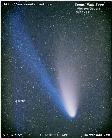
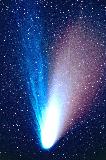


Left: This is a long telephoto shot, using a 6x7 camera on an AstroPhysics 610mm f6 lens w/field-flattener (Traveler). Note: the moonlit conditions actually make the sky background bluish-gray, but the background has been adjusted black-gray for visual evaluation. The ion tail is very strong , and extends out of the frame (in spite of moonlight) -- at least 6 deg. The dust tail has become more intense (brighter and narrower), but still has an outer *fan*. Copyright┐1997 Bob Yen (byen@ix.netcom.com) (http://www.comet-track.com/hb/hb.html)
Right :This image is from a 14 minute exposure on Fuji G-800 film taken
with a Genesis 4" F/5 on 08 March 1997 at 12:15 U.T. It was shot from
North of Red Rock State Park, CA. The negative was scanned on Photo-CD,
processed in Photoshop 3.0.4 using various techniques to bring out the
delicate tail structure. Note the emerging structure in the dust tail
of the comet.
James R. Foster
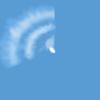


Left: Drawing of the hoods on Hale-Bopp in the early morning sky Mar. 8.58 UT by Marcus Pun (e-mail: marcus@totalvideo.com) from Oakland, CA
Center: Image of Hale-Bopp taken on March 7 using a 10" MEAD reflector, Minolta 35mm X700 camera & 1600 speed film {FUJI} The exposure was 4 minutes. Tony Alonso (sfaris@edge.net)
Right: Hale-Bopp image were near Innsbruck/Austria on the 11.03.97; 3.56 UT. with a 200mm lens on Kodak Pro Gold 400 6x6 film; 18min by Bruno Stampfer, Martin Dandrea and Rainer Eisendle Heiligkreuz Observatory, Hall in Tyrol, Austria, Europe

Image of Hale-Bopp taken using a 180mm f/5.6 lens, and shows a two-frame mosaic. The field of view along the diagonal is about 3.4 degree. Each frame 2 min exposure. Image has been log-scaled. CCD SBIG ST-7 Location: Ceccano (FR) Italy, 231 meters above sea level. Gianluca Masi (gianmasi@fr.flashnet.it)
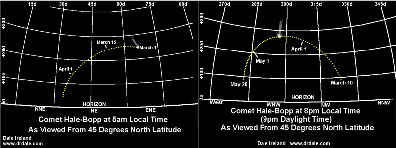
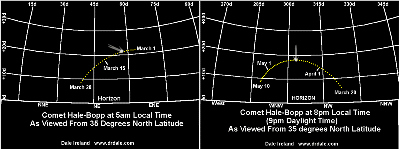


 Comets Currently
Visible (3/12/97)
Comets Currently
Visible (3/12/97)
 The Great Comet of 1997...
The Great Comet of 1997...
 Recent News and Observations (3/14/97)
Recent News and Observations (3/14/97)
 Comet Light Curves (3/14/97)
Comet Light Curves (3/14/97)
 Comet Definitions
Comet Definitions
 Other Sources of Comet Information (2/2/96)
Other Sources of Comet Information (2/2/96)
 Comet Images (2/5/97)
Comet Images (2/5/97)
 Other Pages Featuring Comet Images
Other Pages Featuring Comet Images
The biggest reward for doing this home page is the positive feedback that
I get and the knowledge that users find this page a useful service.
In February 1996, Iway rated the COHP as one of the best 500 Web pages. In fact,
they felt that it was the 15th best science page on the Web! Their
reviews of the 25 top science home pages are given in
this link.
This home page has also been recognized by Magellan, an independent outside
reviewer, as a three-star site. You can search the Magellan database of
1.5+ million sites from the
Other Sources of Comet Information page.
The Comet Observation Home Page was been selected to receive the Griffith
Observatory Star Award for the week of February 2 - 8, 1997 for excellence in
promoting astronomy to the public through the World Wide Web.
(Of course, I think it should have received four stars, but I am a bit biased.)
Typically, about 1,000 individual users/computers access this page every day. These
accesses create more than 15,000 entries per day in the access log. This
amounts to an increase in the size of the access log of 1.5 Mbytes per day!
However, the peak access rate during the C/1996 B2 (Hyakutake) apparition
was 20,000+ users on March 25, 1996. During that date there were 374,132
entries in the access log accounting for ~30 MByte increase in the size
of that file!!

Other Places

Awards

![]()
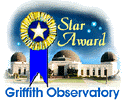

Statistics

This feedback form doesn't work always because of the significant load on this machine...
if there is an error, please send regular e-mail...thanks, csm
Comments? (Please include your
e-mail address. Often times your comments/questions require an individual response. I
can't provide that if I don't know how to contact you!!)
